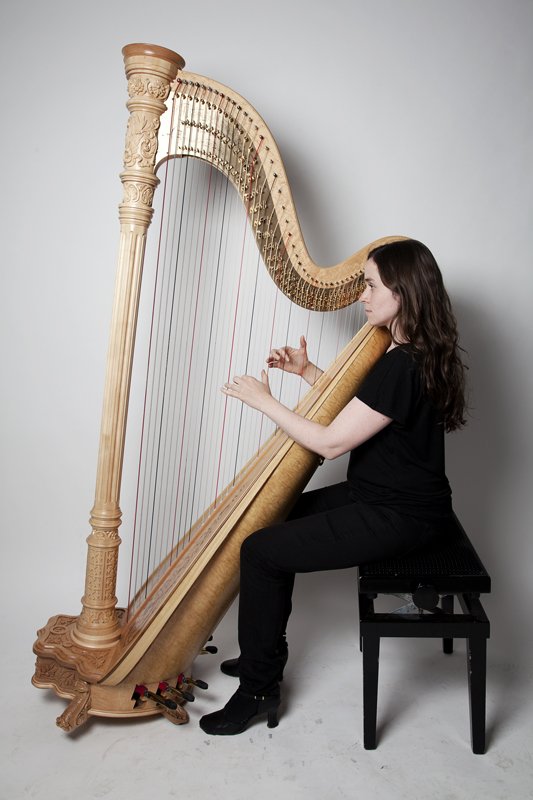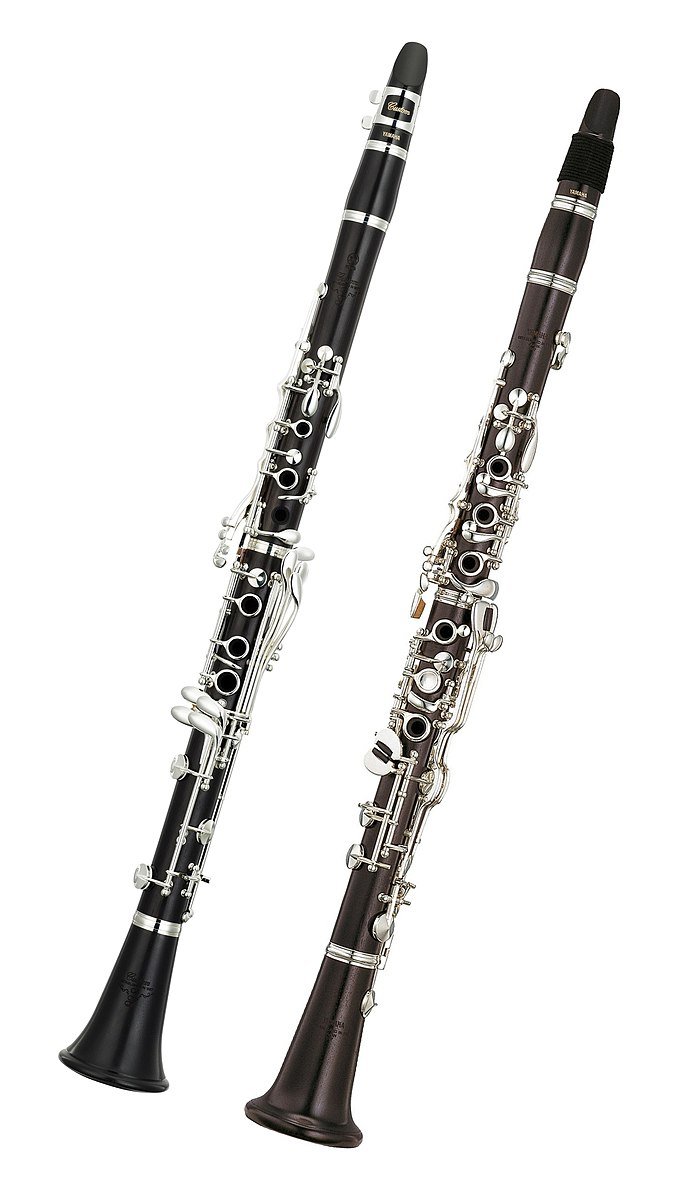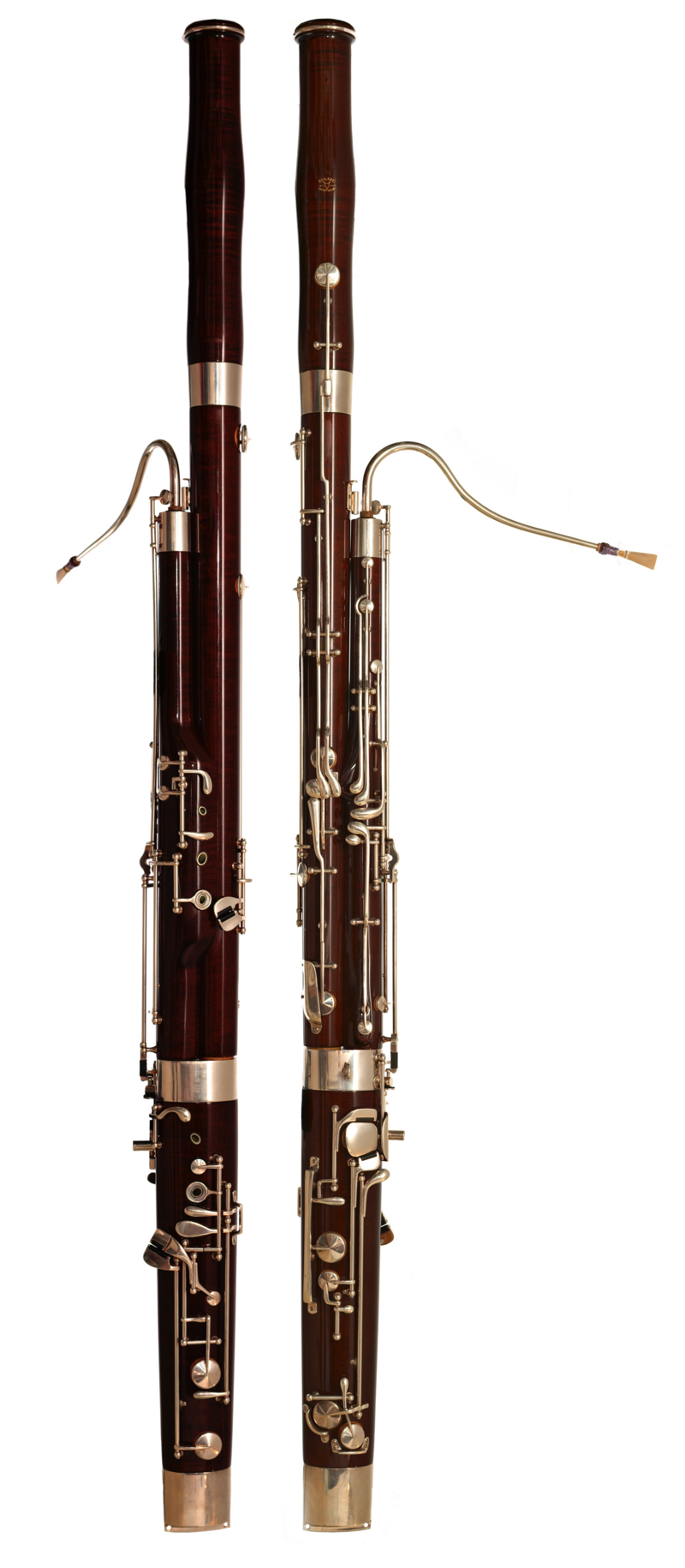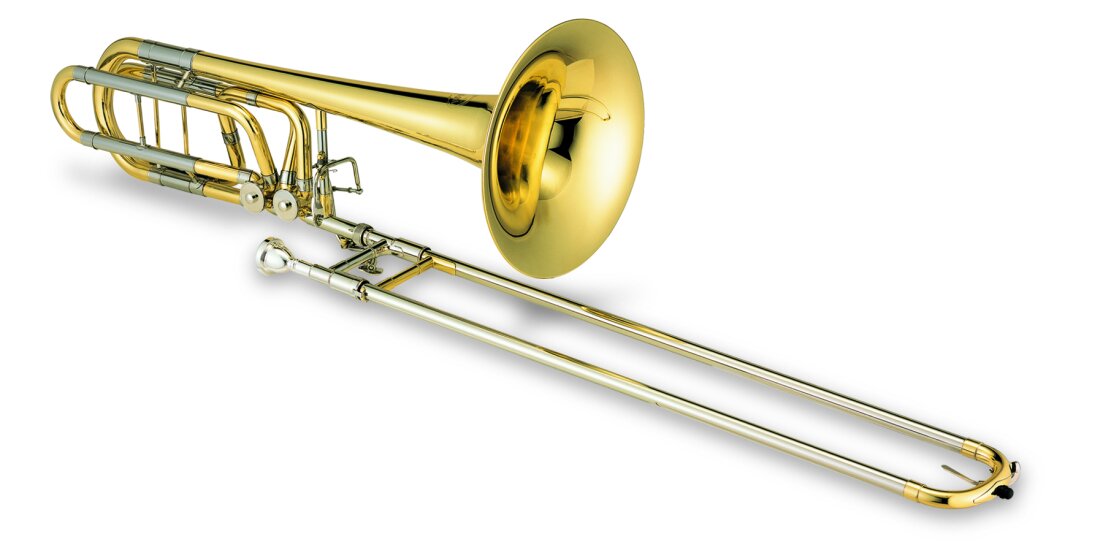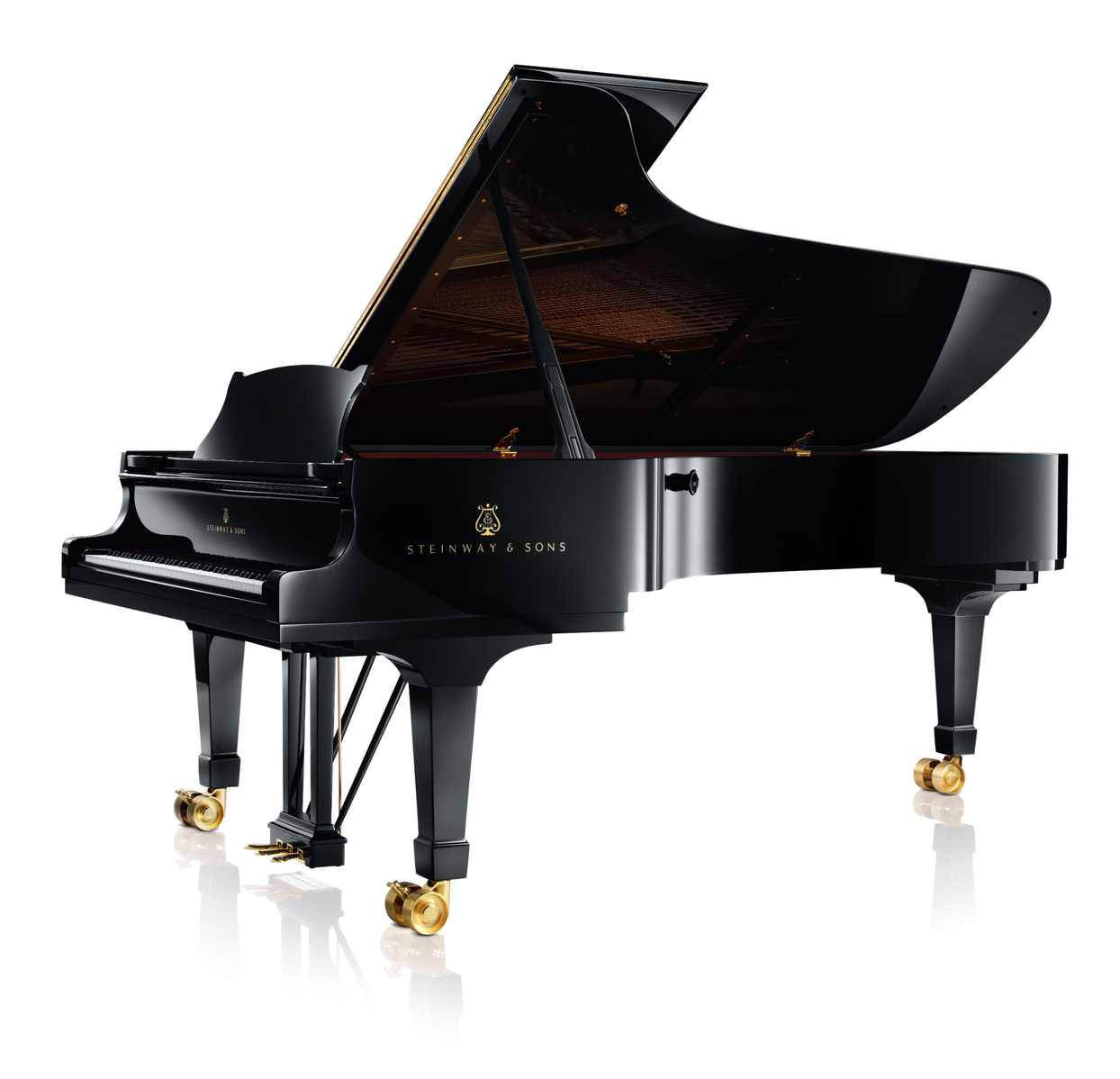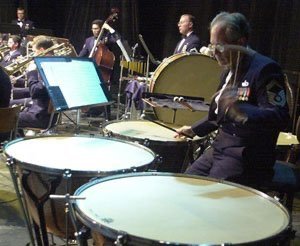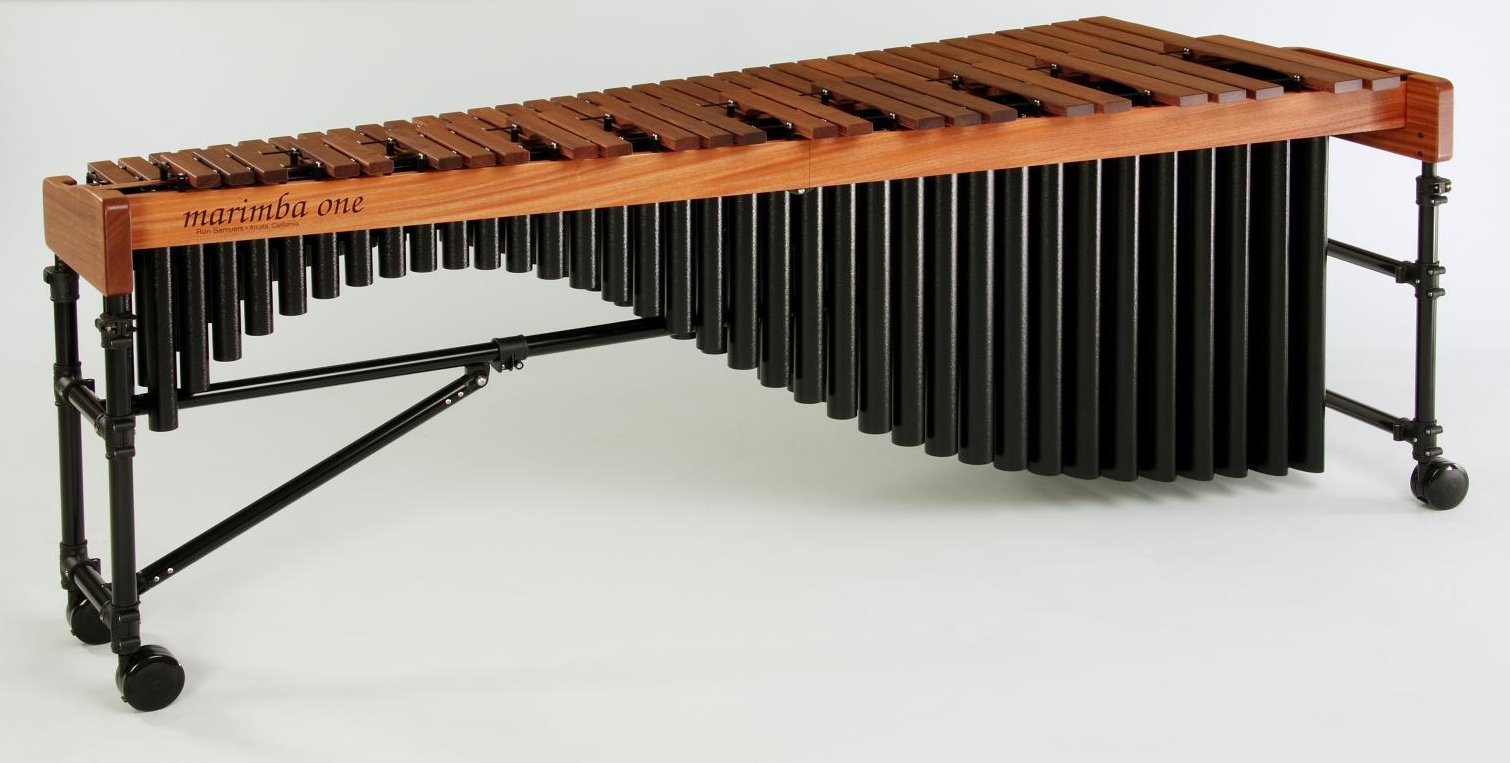Adventures with Beethoven
Scene Four
Who Plays in the Orchestra?
The orchestra is made up of four sections: strings, woodwinds, brass, and percussion. Each section is made up of a variety of instruments that are sometimes called families. The instruments are grouped together in families because of some shared characteristic, such as what they are made of, how they make a sound, or how they look. Many instruments have larger or smaller versions that create higher or lower pitches. Like many families, there are similarities, however each member has its own unique voice and personality. When these different instrument families are combined, the composer has a wide variety of sounds and ranges to explore to express their musical ideas for the audience.
Strings
The largest family is the string section, which includes violins, violas, cellos, and double basses (bass is pronounced “base”). String instruments feature a body made of wood, which is hollow inside, and strings that run down the length of the instrument. Modern instruments feature strings made of nylon, steel, and sometimes Kevlar, which is the material used in bullet-proof vests. Earlier instruments would have used natural materials for strings, such as silk or catgut. Although it was called catgut, it didn’t really come from cats, rather it was the fibers found in the intestines of other animals, usually sheep or goats. Most string instruments feature four strings tuned a fifth apart. The lowest string is on the left and the highest is on the right.
To create a sound, a string player uses a bow, which features a wooden handle and strings, usually made of hair from a horses’ tail, held under tension. The player pulls the bow across the string, which causes it to vibrate, making the sound. To create a different effect sometimes a player will pluck the strings with their fingers, called pizzicato, and sometimes they use the wooden part of the bow to strike the strings, called col legno.
String family - violin-viola-cello-string bass, from Sutori.com
The four main instruments of the string section all look very similar. The violin is the smallest member of the family and plays the highest notes, similar to the sopranos in a choir. The violin section is the largest in the orchestra; there can be up to thirty violins. The group is divided into two parts; the first violins usually play the melody, while the second violins play both melodic lines and harmonic parts. A violin is about two feet long; the bow is slightly longer. The violin is held between the left shoulder and the chin. The left hand pushes down on the strings to play different notes while the right hand moves the bow back and forth across the strings.
The viola is slightly larger and has a lower pitch than the violin. It has thicker strings and often sounds warmer and richer than the violin. It is held and played in the same manner as a violin. The viola section usually features ten to fourteen players. Often the viola section provides the harmony lines and is the alto voice in the string family.
Next comes the cello, which is a much larger instrument at almost four feet long. Because of its size, it can’t be played under the chin. The cello is played by putting the body of the instrument between your knees with the neck of the instrument resting on the left shoulder. To stabilize the instrument, there is a metal peg in the end that rests on the ground. Like the violin and viola, the left hand presses down the strings, while the right hand moves the bow (because of how the instrument is held, it feels like patting your head and rubbing your tummy at the same time while you play!). Most orchestras have eight to twelve cellos who play melodies and harmonies. Many people think the cello sounds the most like the human voice and with its wide variety of tones and its wide range, the cello is a very expressive member of the string family.
The largest member of the string family is the double bass. It is over six feet long and plays some of the lowest notes in the orchestra, often providing the harmonic foundation for the group. The instrument is so big that the players usually stand up or use a tall stool to play their instrument. Like the cello, the bass has a peg at the bottom to help support the instrument. The basses can be quiet at times, but can create a fierce, low growl that adds excitement to the orchestra.
Harp and Harpist, from Harp Notation
The harp is very different from the other members of the string family. It is made of a wooden frame that stands six feet tall and has forty-seven strings in various lengths that correspond to the white keys on the piano. The harp also has seven foot pedals on the bottom that changes the pitches of the strings to allow the harp to play sharps and flats. To make it a little easier to navigate the strings, all the C strings are red and all the Fs are blue. The harpist plays with the instrument between their legs and leaned back, resting on the right shoulder. The musician plucks the strings with their fingertips and thumbs to create a sound. Harps aren’t used in every orchestral piece, most of the time there is only one harp (although Berlioz called for four in Symphony Fantastique!) Harps appear usually only when the composer wants a special and specific color for a melody.
Woodwind Family, from Buchanan Music
Woodwinds
The woodwind family includes flute, oboe, clarinet, saxophone, and bassoon. Most of these instruments were originally made of wood and were simple tubes with finger holes along the pipe, an opening at the bottom, and some kind of mouthpiece at the top. The instruments are played by blowing air through the pipe, hence woodwind. The holes in the tube were covered to create different notes. As the instruments developed, keys were added to make playing the instruments easier and to add the availability of more notes. The clarinet, saxophone, oboe, and bassoon all use a reed, a thin piece of wood that vibrates when you blow. Clarinets and saxophones use a single reed attached to a mouthpiece, while oboes and bassoons use a double reed, two pieces of wood joined together. Like the string instruments, the smaller instruments are higher pitched, while the larger are lower. The instruments in the woodwind section each have families of their own with larger and smaller versions that play at different pitches.
Flute and Piccolo, from Kessler and Sons
The flute is the oldest of all pitched instruments and would have originally been made of stone, clay, or a hollow piece of reed, like bamboo. Modern flutes are made of silver, gold, platinum, or wood and feature numerous keys. To play, the flute is held horizontally with the left hand on top and the right hand on the bottom. The musician blows across the mouthpiece with a small hole in the center, similar to blowing across the top of a soda bottle. By pressing the keys, the note changes. There are usually two or three flutes in the orchestra and they often play the melody. The flute family includes the piccolo, which is very small and high pitched, as well as the larger alto and bass flutes which play lower and sound mysterious.
The oboe is a black cylinder, usually made of wood, that features a double reed. It looks a lot like a clarinet but is thinner and has a very different sound. To play the oboe, the reed is placed in the mouth and you blow through the opening. The air causes the reeds to vibrate together which creates the sound. The notes are changed by pressing a variety of keys. There are usually two or three oboes in an orchestra. Their unique sound can be somewhat sad and haunting, or joyful and playful. The oboe also has a special job, the first oboist plays the note “A” before the concert that all the musicians match to make sure the orchestra is in tune. Like the flutes, the oboe family has a variety of members. The most commonly used is the English horn, which isn’t English or a horn, rather it is a lower pitched version of an oboe which is used in some orchestral works for special melodies.
Oboe Reeds, from Wikipedia
Oboe, English Horn, and Bass Oboe, from Oboe Insight
Bb Clarinet, from Wikipedia
The clarinet is also a black, wooden cylinder, but unlike the oboe, only uses one reed which is attached to a mouthpiece. Like the oboe, when the musician blows into the instrument, the reed vibrates creating the sound. Usually there are two or three clarinets in the orchestra. The clarinet has a wide range. It can sound mysterious or jazzy in the low registers or resonant and bright on the upper notes. The most common instrument is the B♭ clarinet, but there are other versions of the instrument and sometimes more than one clarinet is needed in a single piece. The most common other clarinets are the E♭ clarinet, which is smaller and higher pitched, and the bass clarinet which is lower and darker.
Eb Alto Saxophone, from Wikipedia
The saxophone is a newer instrument and is infrequently used in the orchestra. Although it is made of brass, it uses a reed and mouthpiece like other woodwind instruments. The instrument was invented in Belgium in the 1840s by Adolphe Sax. Like other woodwind instruments, the saxophone family has numerous members in different size with different pitches. The most common is the E♭ alto saxophone, but there are also soprano, tenor, and baritone versions that are commonly used. Although not often found in the orchestra, some 20th century composers have included them for a unique color, such as in Bolero, An American in Paris, and Rhapsody in Blue.
Bassoon, from Wikipedia
The bassoon is the lowest member of the woodwind family. It features a long wooden pipe which is doubled in half and many keys. The bassoon is bent to allow the musician to play the instrument more comfortably, unbent the bassoon would be nine feet long! The bassoon also uses a double reed, but unlike the oboe where the reed is inserted directly into the instrument, the bassoon has a special pipe which connects the reed to the instrument called a bocal. There are usually two or three bassoons in the orchestra. They play lower harmonies, often with the cellos, with whom they share a range. But the bassoon is also featured for melodies too, featuring their unique reedy sound. The contrabassoon is the larger, lower version of the bassoon. It is so long that it takes two bends to allow the musician to hold it. When the contrabassoon plays its lowest notes, it can make the ground vibrate!
Brass
The brass family features instruments made of...brass! These instruments can be very loud and exciting. Originally these instruments would have been made of wood, shells, or animal horns. Each instrument is basically a long tube that is bent in different ways before ending in a bell-like opening. To play a brass instrument, the musician buzzes their lips against the cup-shaped mouthpiece. The mouthpiece amplifies the buzzing of the lips which creates the sound. Rather than keys, most brass instruments have valves that have a button-shaped key on top. To create different pitches, the musician buzzes their lips harder or softer, creating a higher or lower note.
French Horn, from Wikipedia
The French horn is a horn that comes from France. The modern version is based on a hunting horn used in France in the 1600s. The French horn can play lovely, mellow tunes or play loud fanfares. The horn has almost eighteen feet of metal tubing which is curved around itself into a circular shape before ending in a large bell. The musician uses their left hand to play the three valves creating the notes, while the right hand supports the bell. To change the sound of the horn, the musician can place their hand inside the bell modifying the sound and volume of the note. The orchestra has between two and eight horns, depending on the piece.
Six High Brass Instruments Left, from top: A reproduction baroque trumpet in D, a modern trumpet in B♭, a modern trumpet in D, a piccolo trumpet in B♭ (octave higher), and a flugelhorn in B♭. Right: a cornet in B♭, from Wikipedia.
The trumpet has been used for a very long time. The original trumpets were made of shells, animal horns, and eventually metal. The trumpet has often been used to sound alarms, call armies to battle, gather people for announcements, and in parades. The trumpet is the smallest and highest of the brass instruments and has a bright, vibrant sound which adds excitement and color to the orchestra. The trumpet features a slender brass tube which coils over itself and three valves. Most orchestras use two to four trumpets.
Tenor Trombone in Bb, from Wikipedia
Bass Trombone, from long-mcquade.com
Although still made of brass, the trombone has one big difference from its other family members, it doesn’t have valves! Instead, the trombone uses a slide to change the pitch. A trombone has two long, thin u-shaped pipes. One pipe slides into the other and the musician moves the slide in and out with their right hand into one of seven positions to get each note.
Like all the other brass instruments, the trombone uses a mouthpiece and buzzing lips to create the sound. Usually there are two or three trombones in the orchestra. They play in the same range as the cellos and basses and often play harmonies either within their section or in combination with other instruments.
The tuba is the largest and lowest member of the brass family. It is made up of almost sixteen feet of tubing that is coiled around itself, ending in a large bell that points up above the musician’s head. The tuba is held on the players lap and has three valves. Tubas can vary a little bit in size and like all other instruments, the bigger it is, the lower the sound. There is only one tuba in the orchestra and they often provide the harmonic bass line for the entire orchestra.
Bass Tuba in F, from Wikipedia
Percussion
Percussion are some of the oldest instruments; for millennia humans have hit different items to create a sound. Any instrument that makes a sound when hit, scraped, or shaken is considered percussion. This might sound easy, but percussionists need to know exactly where to hit a certain instrument and how hard to strike it to get just the right sound at the right time. There are two main classes of percussion instruments, tuned and untuned. Tuned percussion instruments can sound a specific pitch, such as timpani, marimba, xylophone, and piano. Untuned percussion do not have a certain pitch such as bass drum or cymbals.
Percussion Family, from MrMaglocci.com
Percussion Mallets and Sticks, from Wikipedia
Percussionists help keep the rhythm for the orchestra and add interesting effects and color to the music, often portraying certain sound effects, like the whip in Sleigh Ride. Most of the time, percussionists must play many instruments in each concert, sometimes several in each piece. Some composers use a lot of percussion in their works, while others use only one or two instruments. Percussion can add exciting and different sounds and are some of the most interesting instruments in the orchestra. Sometimes the percussion section even gets unusual instruments, or things you might not consider instruments at all! Composers have included car horns, whistles, Slinkies, and even trash cans in their music, all of which fall to the percussion section. The most common percussion instruments in the orchestra are piano, timpani, xylophone, cymbals, snare drum, bass drum, chimes, and celesta.
Steinway & Sons Concert Grand Piano, Model D-274, from Wikipedia
Why is the piano listed in the percussion section? It has lots of strings, several for each of its 88 keys. But it also uses hammers to strike those strings. Most often, because of the striking action, the piano is considered a percussion instrument. (Visit the History of the Piano ADD LINK to learn more) The piano isn’t always a part of the orchestra, but some composers use it to add harmonic richness, especially since a pianist can play big chords all by themselves. Pianos also commonly appear with the orchestra as a soloist, usually in concertos (Watch for the upcoming Adventure about concertos).
Timpanist playing timpani in the United States Air Forces in Europe Band, from Wikipedia
In the back of the orchestra are four large drums that look like shiny, brass bowls. These are the timpani or kettledrums. The drums are large copper cauldrons with a drumhead stretched over the top. Timpani can be tuned to a specific note by changing the tension of the drumhead by raising or lowering a pedal at the bottom of the drum. The percussionist plays the timpani by striking the drumhead with sticks or mallets. The musician needs to have a good sense of pitch so they can change the tuning during the concert. Timpani are used frequently in the orchestra because they can provide rhythmic support as well as melodic lines.
Orchestral Xylophone (left) and Marimba (right), from Wikipedia
Marimba - Marimba One Concert 4000 Series, from Wikipedia
Xylophone is one example of a mallet percussion instrument, other examples are marimba, glockenspiel, and vibraphone. These instruments feature bars, made from wood or metal, that are arranged like the keys on a piano. Below each bar is a tube, made of metal or wood, which is called a resonator that vibrates when the key is struck, producing the note. By using harder or softer mallets, the percussionist can change the sound of the instrument. Xylophones have wooden bars and metal resonators which create a brighter sound. The marimba has wooden bars and resonators and features a mellower, warmer tone. The vibraphone has metal bars and resonators with rotating discs inside. The vibraphone is attached to a small motor that creates vibrato, a wobbly vibration in the pitch. The glockenspiel is a small version of a xylophone with metal bars which has a high-pitched, tinkly sound.
Snare Drum with Snare Visible on Underside, from Pixabay.com
The snare drum is a small, cylindrical drum with heads on both ends. On the bottom head is a set of wire-wrapped strings, called snares, which run across it. When the drum is struck, these strings rattle, giving the snare drum its unique sound. The snares can be turned off with a small switch on the side of the drum, allowing the drum to either rattle or not, depending on what the piece calls for. Drummers can use sticks, mallets, or brushes to strike the drumhead to create different sounds. Snare drums are used often in military music and in marching bands. They keep exact rhythm for a piece and are used for drumrolls.
The bass drum is the largest and lowest percussion instrument. It is shaped like a snare drum but doesn’t have snares on it. Usually, the bass drum is on a frame and is vertical, rather than horizontal. The drum is played with large sticks that have felt or sheepskin on the end. Although it is a large instrument, the bass drum has a wide dynamic range and can be played softly or can create huge booming sounds.
Bass Drum Typically mounted for Concert Bands and Orchestras, from Wikipedia
Celesta, from Wikipedia
The chimes are metal tubes of different lengths hooked to a metal frame. Each tube is a different pitch, and they are struck with a hard mallet. Chimes sound like church bells.
The celesta looks like a miniature piano and sounds like tinkly bells. Celesta have 49-65 keys and are played like a piano, but it has a different high pitched sound. Like the piano, the musician can play chords.
The percussion section includes many other instruments including castanets, small pieces of wood that are attached together and have a clicking sounds. Cymbals are large bronze discs. They come in a variety of sizes, with larger cymbals having a lower tone. Cymbals can come in pairs which can be crashed together or can be hung and played with sticks, mallets, or brushes. Gongs look like cymbals but are much larger and have a raised section in the center. Gongs are hit with soft mallets. Depending on how hard you hit the gong, it can sound like a quiet rustle or a huge crash. Tambourines have a drum in the middle surrounded by metal jingles, combining the sound of drums and cymbals in one instrument. The triangle is a metal tube shaped like a triangle that is held by a string and stuck with a metal beater. The list of percussion instrument goes on and on, but each one has a place in the orchestra and creates fun and exciting sounds.
Conductor
The conductor or director is the final part of the orchestra. This person leads the orchestra by keeping the beat with their hands and arms. Most conductors use a baton, a thin stick made of metal or wood which helps the musicians see the beat more easily. Conductors not only keep the orchestra together, but help the musicians come in on time and tell different sections to play more loudly or quietly. The conductor leads the group’s rehearsal before the concert, helping the musicians to learn their part and imparting their own interpretation of each piece.
An important role that most conductors or directors have is choosing the programming, or music selections, that the orchestra will play in concert. They carefully choose pieces to present each concert season, often programming a mix of audience favorites with new pieces that might not be as familiar. In this part of their role, the conductor can introduce new compositions and highlight works by diverse composers, as well as presenting standard repertoire to share a wide variety of musical experience with the musicians and audience.
Maestro Michael Wheatley, Skagit Symphony, from Symphony staff
Assistant Conductor Jacob Scherr, Skagit Symphony, from Symphony staff
Orchestras are made up of a wide variety of instruments that come together to create beautiful music. Each instrument adds its own unique voice to create a more beautiful whole. Without all the different colors in the orchestra, the music would be much less exciting. Try to listen for each instrument in the orchestra and see what they add to the performance. Which instrument or section is your favorite?
Check out Meet the Orchestra to hear some fun examples of various instruments!

